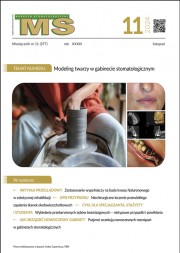Pobierz plik z artykułem
Streszczenie
W artykule opisano leczenie młodej pacjentki z patologicznym starciem zębów, będącym efektem wady zgryzu i wynikającej z niej dysfunkcji narządu żucia. Leczenie wymagało połączenia działań z zakresu ortodoncji, periodontologii i protetyki. Połączenie ww. specjalności pozwoliło na przeprowadzenie leczenia uwzględniającego zarówno rekonstrukcję uszkodzonego uzębienia, jak i eliminację przyczyny powstania patologii. W artykule podkreślono istotne znaczenie aspektu funkcjonalnego i estetycznego w planowaniu i prowadzeniu terapii wielospecjalistycznej.
Abstract
The article presents the treatment of a young patient affected by a pathological tooth wear due to malocclusion and the resulting dysfunction of the masticatory system. Effective treatment required a combination of orthodontics, periodontics and prosthetics. The combination of the aforementioned specialty allowed to carry out effective treatment taking into account both the reconstruction of damaged dentition and the elimination of the cause of the pathology. The article emphasizes the importance of the functional and aesthetic aspect in the planning and conduct of multi-specialized therapy.
Hasła indeksowe: patologiczne starcie zębów, leczenie wielospecjalistyczne
Key words: pathologic tooth wear, multidisciplinary treatment
PIŚMIENNICTWO
1. Verrett R.G.: Analyzing the etiology of an extremely worn dentition. J. Prosthodont., 2001, 10, 4, 224-233.
2. Grippo J.O.: Abfractions: A new classification of hard tissue lesions of teeth. J. Esthet. Restor. Dent., 1991, 3, 1, 14-19.
3. Lee W.C., Eakle W.S.: Stress-induced cervical lesions: Review of advances in past 10 years. J. Prosthet. Dent., 1996, 75, 5, 487-494.
4. Levitch L.C. i wsp.: Non-carious cervical lesions. J. Dent., 1994, 22, 4, 195-207.
5. Lussi A.: Dental erosion. Clinical diagnosis and case history taking. Eur. J. Oral Sci., 1996, 104, 2, 191-198.
6. Loomans B. i wsp.: Severe Tooth Wear: European Consensus Statement on Management Guidelines. J. Adhes. Dent., 2017, 19, 111-119.
7. Davies S.J., Gray R.J.M., Qualtrough A.J.E.: Management of tooth surface loss. Brit. Dent. J., 2002, 19, 11-23.
8. Niswonger M.E.: Rest position of the mandible and centric relation. J. Am. Dent. Assoc., 1934, 21, 9, 1572-1582.
9. Atwood D.A.: A critique of research of rest position of the mandible. J. Prosthet. Dent., 1966, 16, 5, 848-854.
10. Olsen E.S.: A radiographic study of variations in the physiologic rest position of the mandible in seventy edentulous individuals. J. Dent. Res., 1951, 30, 517-525.
11. Atwood D.A.: A cephalometric study of rest position of the mandible. Part I. J. Prosthet. Dent., 1956, 6, 4, 504-519.
12. Atwood D.A.: A cephalometric study of rest position of the mandible. Part II. J. Prosthet. Dent., 1957, 7, 4, 544-552.
13. Tallgren A.: The reduction if face height of edentulous and partially edentulous individuals during long term denture wear: a longitudinal roentgenographic cephalometric study. Act. Odontol. Scand., 1966, 24, 2, 195-239.
14. Kois J.C., Phillips K.M.: Occlusal vertical dimension: alteration concerns. Compend. Contin. Educ. Dent., 1997, 18, 12, 1169-1177.
15. Abduo J.: Safety of increasing vertical dimension of occlusion: a systematic review. Quintessence Int., 2012, 43, 5, 369-380.
16. Gurel G.: Porcelain laminate veneers: minimal tooth preparation by design. Dent. Clin. North Am. 2007, 51, 419-431.
17. Goodacre C.J. i wsp.: Clinical complications in fixed prosthodontics. J. Prosthet. Dent., 2003, 90, 31-41.
18. De Backer H. i wsp.: Single-tooth replacement: is a 3-unit fixed partial denture still an option? A 20-year retrospective study. Int. J. Prosthodont., 2006, 19, 567-573.
19. Lange R.T., Pfeiffer P.: Clinical evaluation of ceramic inlays compared to composite restorations. Oper. Dent., 2009, 34, 263-272.
20. Layton D.M, Clarke M., Walton T.R.: A systematic review and meta-analysis of the survival of feldspathic porcelain veneers over 5 and 10 years. Int. J. Prosthodont., 2012, 25, 590-603.
21. Gurel G., Calamita M.A., Coachman C.: Clinical performance of porcelain laminate veneers: outcome of the aesthetic pre-evaluative temporary (APT) technique. Int. J. Periodontics Restorative Dent., 2012, 32, 625-635.
22. Sailer I. i wsp.: All-ceramic or metal-ceramic tooth-supported fixed dental prostheses (FDPs)? A systematic review of the survival and complication rates. Part I: Single crowns (SCs). Dent. Mater., 2015, 31, 603-623.
23. Lila-Krasniqi Z.D. i wsp.: Differences between centric relation and maximum intercuspation as possible cause for development of temporomandibular disorder analyzed with T-scan III. Eur. J. Dent., 2015, 9, 573-579.
24. Dzingutė A. i wsp.: Evaluation of the relationship between the occlusion parameters and symptoms of the temporomandibular joint disorder. Acta Medica Lituanica, 2017, 24, 167-175.
25. Haralur S.B.: Digital evalutation of functional occlusion parameters and their association with temporomandibular disorders. J. Clin. Diagn. Res., 2013, 8, 1772-1775.
26. Funato M. i wsp.: Evaluation of the non-functional tooth contact in patients with temporomandibular disorders by using newly developed electronic system. J. Oral Rehab., 2014, 41, 170-176.













